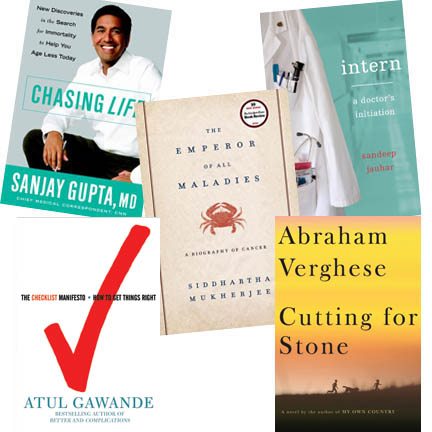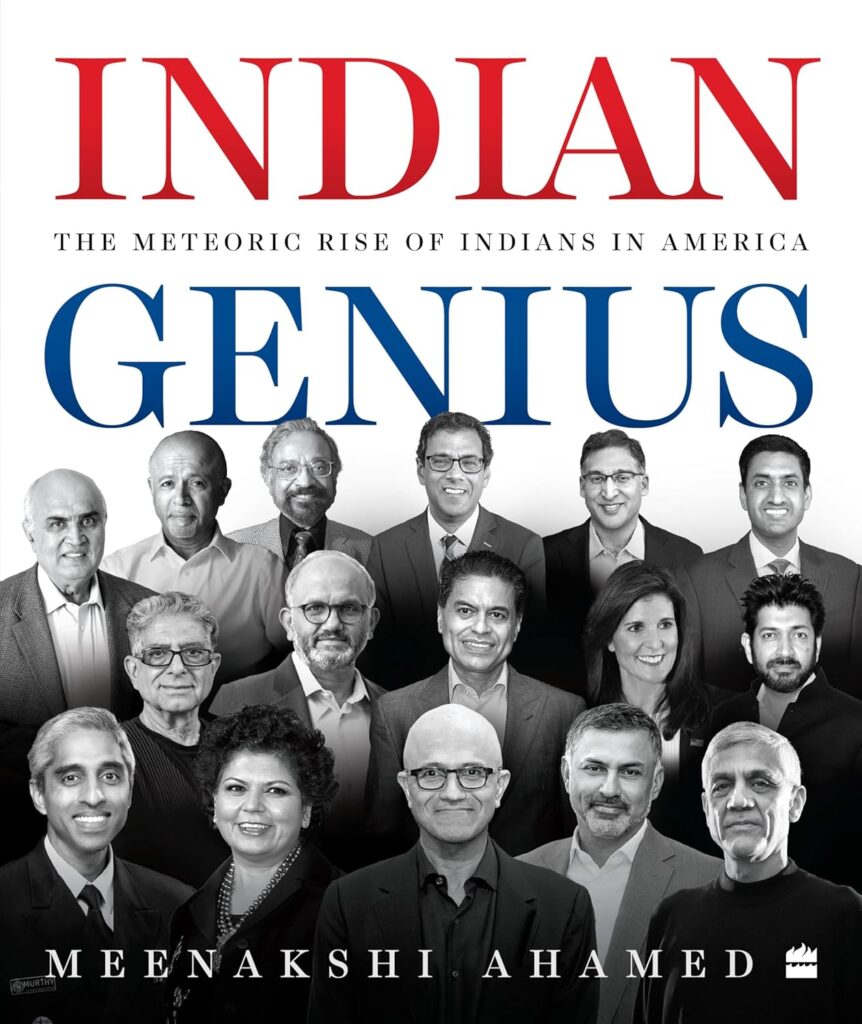
What is Indian genius? Does it exist?
A look at the meteoric rise of the Indian-Americans
It’s the photograph that defines Indian-American success, big time.
On the cover of the book Indian Genius by Meenakshi Ahamed, 16 of the celebrated Indian success stories seem to be posing side by side, beaming, as if sitting for a class portrait.
There are the demi-gods of the tech world – Kanwal Rekhi, Vinod Khosla, Shantanu Narayen, Satya Nadella, Suhas Patil, Nikesh Arora; there are celebrated names like Dr. Deepak Chopra, Grammy winner business dynamo Chandrika Tandon, Fareed Zakaria, Dr. Vivek Murthy. Yes, there are also Congressman Ro Khanna, Nikki Haley and Neal Katyal. Add the noted doctor-writers Abraham Verghese, Siddhartha Mukherjee, and Atul Gawande.
All in one frame.
They all have one thing in common – either they or their parents were born and bred in India: some in small towns, some in villages and some in big cities. Several decades ago, they left their homeland, flying over Indian terrain, mountains and rivers and journeyed to their destiny and their destination: America.
The sub-title of the book is ‘The Meteoric Rise of Indians in America’ and these are names and faces known to all of us who have followed the Indian American success story of India in America. It is a portrait of a lot of power, a lot of strength, a lot of possibilities, all in one image.
The author of the book is journalist Meenakshi Ahamed, herself a member of the $8 Club of immigrants who came to America decades ago with just 8 dollars in their pocket. Her decades in America have been well-spent, astutely observing life from the vantage point of the two countries. She was born in Calcutta and first came here as a student, receiving an MA from the John Hopkins School of Advanced International Studies. She has worked at the World Bank and for NDTV. Last year she published ‘A Matter of Trust: India-US Relations from Truman to Trump.’ Now in ‘Indian Genius’ she takes on a more personal topic – the amazing success of Indians in America seen through the lives of 16 people in ‘Indian Genius’.
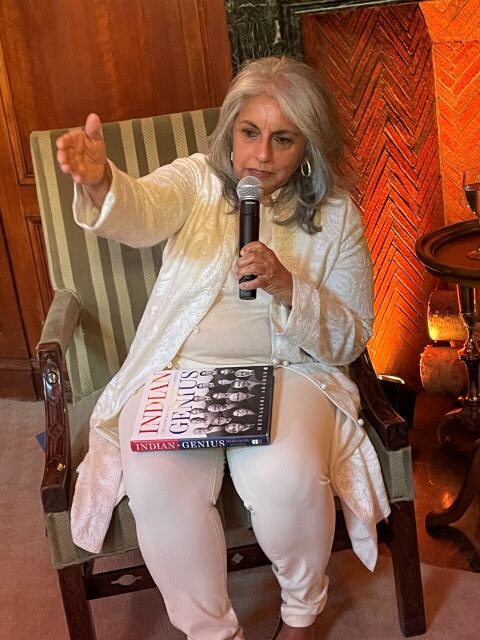
These are the names which are embedded in the modern-day fable of Indian Excellence, which has kind of been dinned into us right from the beginning, by our parents, that there is something superior about Indian values of hard work, resilience and persistence. Although Ahamed does not give Indian values as an elixir which make Indians who they are, but these do exist in each of the stories that she weaves about these band of adventurers who came into the New World and in a few decades, managed to conquer it.
The Indian-American Success Story
Whether you are living in India or you are living in any part of the Diaspora, you have been told about these golden names who created a whole meteoric rise in the tech world, the business world and the public space. Indeed, you could go from Microsoft to Google to Adobe to Starbucks to PepsiCo, and you will always find an Indian hand in it.
What was once a rarity, having an Indian name in a corner office, has now become something so common as to not even make you blink an eye. When Ahamed came into the country, she remembers how few Indian names, Indian faces, there were. From a few thousand, the Indian-American population is 4.4 million, according to the 2020 US Census. And now, when you walk the street, you’re not fazed at all by the expanded Indian presence. Everybody has an Indian in their lives, whether it’s a spouse, an office friend or at least a doctor.
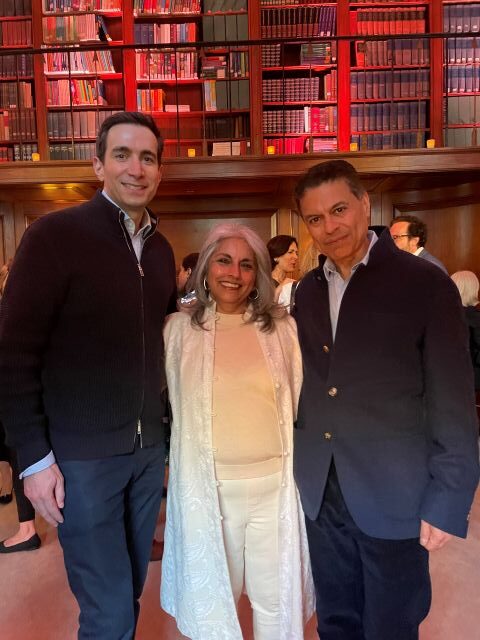
Ahamed first came here to study in America and then joined the World Bank. She hung on to her Indian passport for many years, with a foot in both countries until she and her husband made the decision to stay on and become Americans. This embrace of America gained her a new perspective on life from the other side, where she was able to decipher what really was the strength of an Indian.
Intrigued by the title of her book, I asked her: Is there such a thing as ‘Indian genius’? What does it really mean – is it a synonym for Indian excellence and how does one decide who has it?
Of course, the list can be subjective, depending on the creator of such a list but as Ahamed told me, “First you have to define what genius means. When you talk about American exceptionalism, what is the genius of the American people? What is the genius of the Chinese people? This is really about the genius of the Indians. It’s a collective genius, in the way that I am talking about it.
Look at these Indians. They not only rose to the top, but they also did it in one generation. There’s a sort of genius amongst the Indians, the genius in their culture. So, it’s more about the genius of the people than the individuals, and that is what the book title implies. It’s the genius of the Indian people to be able to succeed in another country, in another culture.”
Indian-American Impact
Ahamed did not necessarily zero in on the wealthy, successful Indians in America. She says, “No question, many of them may be more wealthy than some of the people in my book, but I didn’t pick them because wealth did not interest me. I wanted to see whether someone had an impact in the community on their way up.”
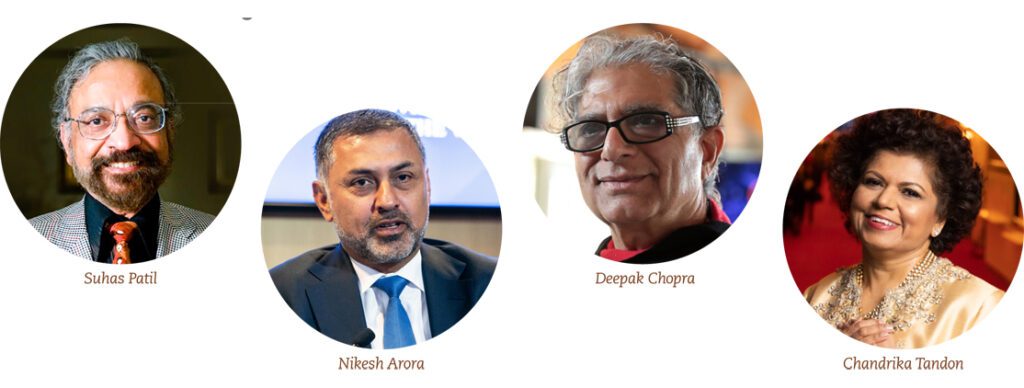
She picked three areas where Indians have had a transformational effect on the American world and have taken significant risks to make that possible. She told me, “I wanted to find people who had moved the needle in some way, and I zeroed in on Technology, Medicine, Public Policy and Leadership.” Rather than make a laundry list of everyone in these categories, she zoned in on five people in each category, so readers could get to know their unique stories, often in their own words, sharing interesting anecdotes from their lives, how they overcame obstacles and their secrets to success.
The ones who come to America are already on a positive track. As Ahamed points out: I would say that for Indians, when you live in a country of 1.5 billion people, competition is ingrained in you. You’re competing for everything from day one, from seats in university to schools to electricity connections to gas connections. So, when you come here you know how to compete.”
The Indian-American Tech Story

Kanwal Rekhi grew up poor in a crowded home without a running toilet. Yet he went on to become the ‘godfather’ of the Indian tech community in Silicon Valley and as Ahamed writes, “Many Indian-Americans recognize that he paved the way for them, breaking several glass ceilings to achieve success. Along the way he had to endure cultural biases and professional inequity.” In fact, his company Excelan was the first fully Indian-American-owned company to go public when it was listed on Nasdaq in 1987. As Rekhi has said, “Indians in the Valley did not look at Bill Gates and imagine they could become him, but when they saw me, another Indian, run a company and go public with it, it inspired them. They felt, ‘If he can do it, why not me?”
And yet even the ones destined to become an Indian genius, make mistakes. Readers will be shocked to know that Kanwal Rekhi, as a newcomer, actually refused an offer from IBM which was the leader in computer mainframes. After working with several other tech companies, when he tried to apply again to IBM, he was told he was barred from ever working with the company because he had given no good reason for refusing the job offer!
At that time Indians had few mentors to guide them but as more Indians created startups Rekhi initiated with these new bold adventurers an organization called The Indus Entrepreneurs to help fund and incubate the new startups by the many Indians entering Silicon Valley. Today TIE has 61 chapters across 14 countries and 15,000 charter members.
Suhas Patil of Cirrus Logic, a fabless semiconductor company, had the Indian genius of ‘Jugaad’ even as a child, building projects from cardboard, metal scrap, and wood. He says, “I had an insight while I was in high school that electronics had legs and as a field had room for growth, so I decided to apply to college in engineering, but I was too young to attend, so I went to Xavier’s where I learned English.” It was however his IIT education and based on his thesis, that he got into MIT on a full scholarship.
The one thing that perhaps Indians do have is the wonderful gift of a stellar education from the Indian government, for the IITs are topnotch and so much harder to get into than even Harvard or Yale. Only the brightest of the bright manage to get into these highly competitive institutions – they give students such a solid background that they are able to take all the punishment of ivy Leagues because they have already been through fire.
As venture capitalist Vinod Khosla explained to Ahamed, “Getting into IIT was the only way to escape whatever was your lot in society. Everyone knew it was a fair playing field – there was no ability to use influence or ‘Who do you know?’ and no one doubted it was a totally performance-based institute. Your community determines how you develop, especially when you are 16 to 20 years old. Then it becomes this filter, a brand of excellence that you are associated with.”
Kanwal Rekhi, Suhas Patil and Vinod Khosla – all IIT graduates, were part of the first tech wave that helped them to create products and lead successful tech companies.
In an interview in the book, Khosla identified what were the traits of those first wave of graduates from IIT who came to America: “It takes a certain kind of personality; smarts are not enough. Education is not enough. You had to have a risk-taking entrepreneurial culture to leave the comfort of home and come to this country not knowing anybody. There wasn’t anybody I knew here. There was no mentor. But this willingness to take risks along with lots of capability is a combination that really works well for Indians in Silicon Valley. Silicon Valley is about performance and it’s not just a place; it’s a mindset.”
Some of these answers given to Ahamed tell you so much about these remarkable people. Asked if he always wanted to be his own boss, Vinod Khosla responded: “I was clear I was coming to the United States to start a company. I was never coming here to just get a job. What makes me happy are the things I’ve pursued. It’s this internal drive to do things that motivates me, not what others expect of me, which is titles, promotions, income, cars and bigger houses.”
Ahamed gives high marks to both Narayen of Adobe and Nadella of Microsoft for being exceptional leaders “who have had a transformational impact on their companies by changing the existing models they were being run on and developing a vision for their futures. They stand out as truly visionary CEOs who have grasped the new frontier that is changing the world with artificial intelligence and are well positioned to lead their companies to the next phase of growth.
Indian-Americans: Transformation and Growth
In her definition of Indian genius, she is intrigued by the transformational aspect of these trailblazers. She talks of Dr. Atul Gawande, author of ‘The Checklist Manifesto, which listed very simple things that hospitals should do that prevent infections and it helped bring infection rates down across the board all over the US by a phenomenal 60%. “He had what I would call a transformative impact on society and medicine. He came back with a second transformational idea, which is how you end life, with his book ‘Being Mortal’, which was somewhat based on and inspired by his father’s death.”
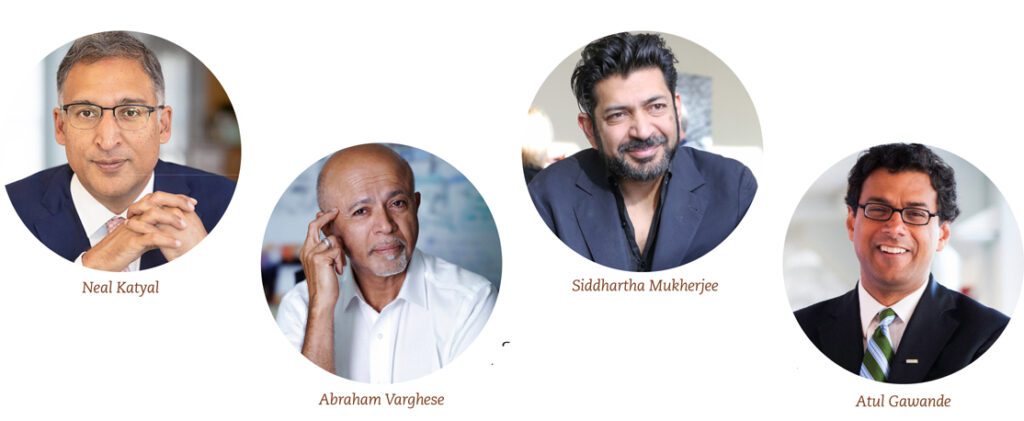
Indeed, doctors are bent on prolonging life at any cost and 90% of healthcare costs in this country are in the last year or two years of a patient’s life. “You have to weigh prolonged life against what the patient wants,” she says. “So, I think it was a transformational idea which had a big impact on the medical community and Americans who hadn’t spent a lot of time thinking about the alternative to prolonged care – maybe hospice care can be an alternative.”
Dr. Abraham Verghese’s work, and writing had a similar effect during the AIDS crisis and Dr. Siddhartha Mukherjee has been a transformative changemaker in the fight against cancer. As Ahamed says, “There’s something called Jugaad in India – It’s kind of a combination of entrepreneurial spirit and grit and learning to do with it less, being able to create something out of nothing – and leaving things better than they found them.”
She points out the transformational qualities in each of the people she has interviewed in the book, from Nadella to Neal Katyal. Nadella made Microsoft one of the most profitable companies on this planet -at one point, it hit 3 trillion. She says he is a visionary who knew what he was doing and stabilized the market.
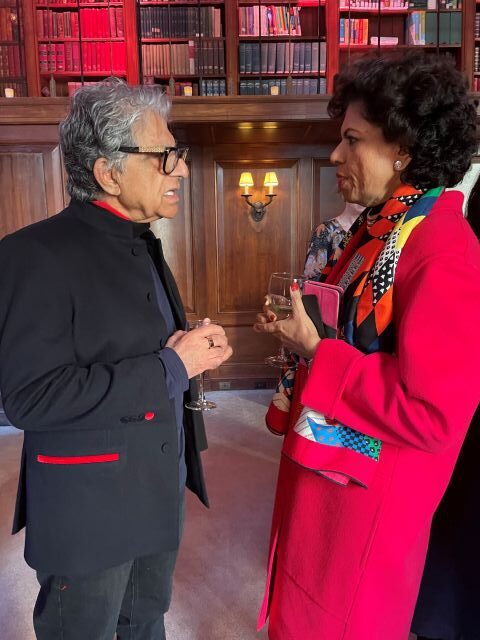
She counts Chandrika Tandon among the Indian Genius list for bold actions, juggad and risk taking in her own life and work, from taking charge of her life by going on a hunger strike to go to the college of her choice to being only one of eight women in an-all male engineering school to becoming the first South Asian female partner in the prestigious firm of McKinsey where she interviewed in a sari and chappals, she took all the bold moves. She took the major risk of starting her own company Tandon Advisory Partners at a time when few women were CEOs and made millions for her corporate clients and for herself, by astute restructuring; and then she took another big risk – taking on music big time and won a Grammy. Along with education and philanthropy, she has adroitly juggled all the balls in the air. As she says: “When you don’t look at boundaries, everything seems connected. Everything seems possible.”
Whether it was the iconic Deepak Chopra who transformed yoga from its perception as a quirky Indian ritual to a mainstream very American habit or Fareed Zakaria who made the Indian-American voice one to be heard and valued in political commentary and thought all over the world, each of them helped change the way Americans think and react to the world. She says of Zakaria, “All of a sudden, everyone from Dubai to Delhi to Des Moines, Iowa were listening to him, and he was giving them a slightly different interpretation of the news and world events. He’s actually been quite transformational in how the news is presented, and people trust him.”
Indian-American Success: Risk Taking and Dealing with Failure
In the face-to-face interviews with all these super-achievers Ahamed gleaned many of their secrets for success, risk-taking and dealing with failure, and these are a valuable read for those wanting to duplicate their success or at least get some ideas on how to jumpstart their own careers.
Of course, it’s true that only the best of the best were able to come in the past because of all the entry restrictions. Yet with the Family Reunification Act, suddenly you had family members who might not have been as educated, also coming in. So, is the Indian genius something which is inherent in in the blood? Is it something which may not be detected early because these people did not go to Ivy League schools or live in swanky neighborhoods?
I asked Ahamed about this, and she agreed that Indians are striving and doing very well. She says, “The number of Indians coming in with a STEM education has certainly made Indians very successful in this country. But whether that leads to genius, I would like to reserve judgment on that.”
She gave the example of the Spelling Bee competitions where Indian-American children have been phenomenal, and the amount of work parents and children put into it is considerable and commendable. But whether that leads to genius is again something she reserves judgement on. She kept a comprehensive chart on spelling bee participants and while many went on to become doctors and engineers, they were not on the genius track. Winning spelling bees led them to perfectly respectable careers but does not lead to becoming CEO of Microsoft, she said.

The Future of Indian Genius in America
In conclusion I asked Ahamed for her reading of the future and the future of Indian genius in America. Now with major changes coming under Trump what does she see in the tea leaves, especially with all the immigration restrictions? She does believe immigration will be harder and people will have more trouble in acquiring legal status here but for people who are already here, she is hopeful.
“There’s always room for excellence, no matter where you are,” she says. “If you have really remarkable abilities and you’re smart and you have something that society wants, there are always going to be to be avenues to succeed. I think that will not change.”
She believes that what is so great about this country is that every one of us has someone in the family that has immigrated from somewhere: “That is the connective tissue that joins us all, and this is something we ought to celebrate. That is something we ought to hold hands on and be proud of. Every wave of immigrants has contributed to this country and Indians are the most recent. We all, every one of us and our ancestors, have contributed towards the American story – so we should be celebrating that.”
(A version of this article first appeared in Khabar Magazine –What’s the Secret Sauce of Their Success? – khabar.com)
Related Articles:
Siddhartha Mukherjee: Chasing Cancer
Related Articles:https://www.lassiwithlavina.com/features/books/the-writer-healers/html
